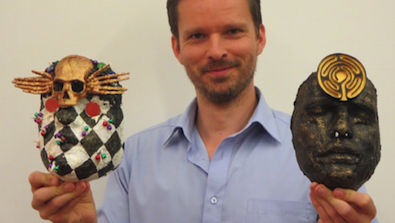
Masks across cultures are used as tools for storytelling. This spring, Barbara Diane Barry led the adult education course “Inside/Out: Creative Mask Making,” inspired by the Rubin’s exhibition “Becoming Another: The Power of Masks.” As the Rubin Museum of Art’s intern for Adult and Academic Programs, I had the pleasure of assisting the adult education course as participants explored and examined identity through a series of mask-making activities.

The material-rich course provided creative outlets for participants to use paint, feathers, beads, moss and other art supplies. Participants made two masks, one representing the outer self—the public role we assume when we engage with others—and the second representing the inner self that is revealed through personal reflection.
The artistic process began with the students forming small groups of two or three people to create their masks. Alternating, the participants took turns gently constructing masks on one another’s’ faces. The intimate process of placing one’s face in a stranger’s hands felt curiously safe and fascinating, according to the comments made by the group.

By stepping out of their comfort zones, students were able to foster new friendships during this experience. For example, Josie Walker and Delores Coan, pictured above, formed a congenial working relationship. Delores used the structure of Josie’s face to capture her likeness with Plaster of Paris strips, laid one on top of the other. Working with this mold, as well as a second one, Josie created two masks that tapped into her New Orleans heritage.

During one of the class sessions, Barbara Barry delivered a lecture on the history of masks across cultures, which launched a barrage of ideas, questions, and discussions. The following week, the class had the opportunity to take a tour of “Becoming Another” with Dr. Jan Van Alphen, the curator of the exhibition. Dr. Van Alphen’s tour delved into the cultures, themes, and stories surrounding the masks in the exhibition, which strongly impacted many participants’ final projects. Delores Coen’s blue mask, picture below, is her interpretation of a shamanic mask she saw in the exhibition. The blue hues represent water and wind. The green represents life and the silver metallic circles repel negative spirits. This mask gives a face to Mother Nature.

Having behind-the-scenes exposure to Barbara’s methods of a course while, at the same time, nurturing participants’ creativity and intuition, opened my eyes to the impact of art and communal art making. Watching the evolution take place creatively, socially, and psychologically was a powerful and memorable experience.
To learn more about upcoming Adult Education workshops and summer classes at the Museum, visit RubinMuseum.org/education/adult-education.
Add Your Thoughts
Comments are moderated, and will not appear on this site until the Rubin has approved them.

